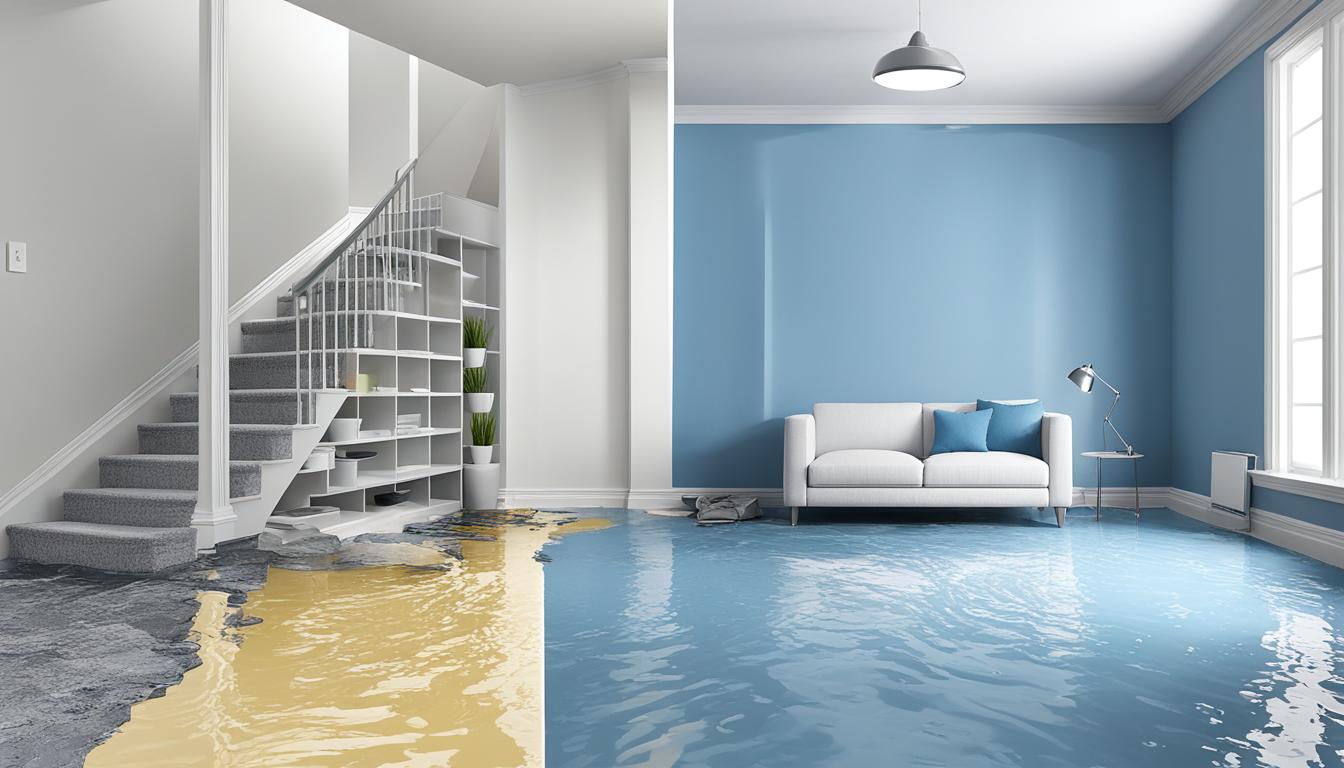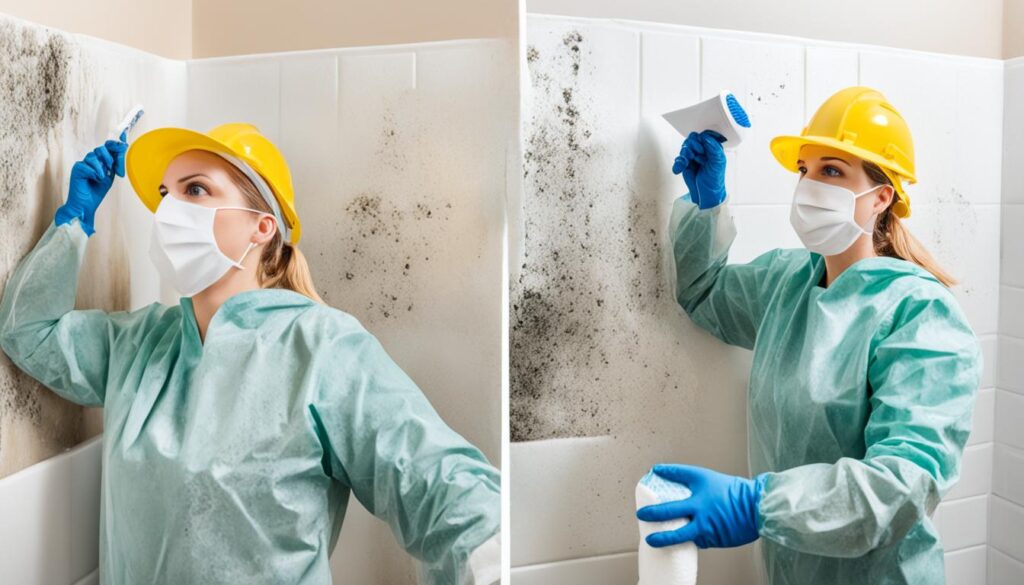
Water Damage and Mold Remediation Process Explained
Welcome to our comprehensive guide on the water damage restoration and mold remediation process. Dealing with extensive water damage and mold growth can be a challenging task, but with the right knowledge and techniques, you can restore your property to its former glory.
In this article, we will walk you through the necessary steps involved in effectively handling water damage and ensuring the safe removal of mold. Whether you’re facing a burst pipe, flooding, or any other water-related issue, understanding the restoration process is crucial for a successful outcome.
Water damage restoration is a multi-step process that requires precision and expertise. From mitigating the initial damage to thoroughly drying and dehumidifying the affected areas, each step plays a crucial role in preventing further issues such as mold growth.
Mold remediation, on the other hand, involves a meticulous process to ensure the complete removal of mold spores and preventing them from spreading to other parts of your property. Effective containment, air filtration, and proper disposal are essential in safeguarding your health and restoring your living or working space.
Key Takeaways:
- Understanding the water damage restoration process is crucial for effectively handling water-related issues and preventing further damage.
- Mold remediation is a meticulous process that requires containment, air filtration, and proper disposal to ensure the safe removal of mold.
- Professional water damage restoration and mold remediation services can provide expertise and effective solutions for a thorough restoration.
- Addressing water damage promptly is essential in preventing mold growth and further structural damage.
- Consulting with professionals is recommended when dealing with extensive water damage and mold growth to ensure a safe and successful restoration process.
Understanding Water Damage Restoration
When facing water damage, it is crucial to act quickly and effectively to minimize the extent of the damage and prevent further issues from arising. In this section, we will provide an overview of the essential steps involved in water damage restoration and highlight the importance of professional assistance.
Step 1: Water Extraction
Water extraction is the first and most critical step in the restoration process. It involves removing standing water from the affected area using specialized equipment, such as pumps and vacuums. This step helps prevent additional damage and reduces the risk of mold growth.
Step 2: Drying and Dehumidification
Once the standing water is removed, the drying and dehumidification process begins. This step aims to thoroughly dry out the affected area, including walls, floors, and possessions, to prevent mold growth and further structural damage. High-powered fans and dehumidifiers are used to expedite the drying process.
Step 3: Moisture Monitoring
After the drying phase, moisture monitoring is crucial to ensure that the affected area is completely dried. Moisture meters and infrared cameras are used to identify any hidden pockets of moisture that may lead to mold growth or other complications if left untreated.
Step 4: Cleaning and Sanitization
Once the area is thoroughly dried, cleaning and sanitization procedures are implemented to remove any contaminants and pathogens that may have been introduced by the water damage. This step helps restore a safe and healthy environment.
Step 5: Restoration and Repairs
Finally, the restoration and repairs phase begins. This includes repairing or replacing damaged materials, such as drywall, flooring, and furniture. The goal is to restore the affected area to its pre-damage condition, ensuring both structural integrity and aesthetic appeal.
While minor water damage incidents can sometimes be handled with DIY techniques, it is important to note that professional water damage restoration services offer several significant advantages. Professionals have the knowledge, experience, and specialized equipment to tackle even the most severe water damage situations effectively. Additionally, they can quickly assess the damage, create a comprehensive restoration plan, and carry out the necessary steps to mitigate further issues.
Professional water damage restoration not only ensures thorough and efficient restoration of your property but also helps prevent potential hazards like mold growth and structural damage. By relying on experts in the field, you can have peace of mind knowing that your home or business is in capable hands.
Next, we will explore the mold remediation process and how to safely restore your property after water damage while addressing potential mold growth.

Mold Remediation Process for Safe Restoration
In the unfortunate event of water damage, mold growth can quickly become a significant problem. To address this issue effectively, it is crucial to understand the mold remediation process. By following the proper steps for safe restoration, you can successfully remove mold from affected areas and restore your property to a healthy and mold-free state.
The mold remediation process typically involves the following essential steps:
1. Containment
To prevent further mold spore dissemination, it is essential to create a controlled environment. Containment involves sealing off the affected area using plastic sheeting and establishing negative air pressure through the use of specialized equipment.
2. Air Filtration
The next step is to improve indoor air quality by implementing air filtration systems. High-efficiency particulate air (HEPA) filters and air scrubbers are utilized to capture and remove airborne mold spores, ensuring a clean and safe environment.
3. Removal
Physical removal of mold-infested materials is a crucial step in the remediation process. Contaminated porous materials like drywall, carpets, and insulation often require complete removal and disposal to eliminate the source of mold growth effectively.
4. Proper Disposal
Mold-infested materials must be handled with care to prevent further contamination. They should be bagged and sealed properly before disposal to minimize the risk of spreading mold spores to other areas of the property.
While some DIY mold removal methods may be suitable for minor mold issues, extensive mold infestations or those affecting large areas of your property are best left to the professionals. Mold remediation specialists possess the expertise and equipment necessary to effectively mitigate mold growth and ensure the safety of your home or business.
It’s important to understand that mold remediation is not just about surface cleaning; it involves addressing the root cause of the mold growth and implementing appropriate preventive measures. Neglecting proper mold remediation can lead to persistent mold issues and potential health risks for occupants.
By following the mold remediation process outlined above and considering professional assistance when needed, you can restore your property to a mold-free and healthy environment.

Conclusion
In conclusion, understanding the mold remediation process and water damage restoration process is crucial for homeowners facing significant water damage issues. Promptly addressing water damage is key to preventing mold growth and mitigating further damage to your property. It is important to remember that handling water damage and mold requires a comprehensive approach and professional expertise.
By following the necessary steps in water damage restoration, including water extraction, drying, and dehumidification, you can effectively minimize the long-term effects of water damage. Additionally, investing in professional water damage restoration services ensures a thorough and efficient restoration process.
When it comes to mold remediation, it is essential to take the necessary precautions to protect yourself and your property. The mold remediation process involves containment, air filtration, mold removal, and proper disposal. While DIY mold removal methods may seem tempting, it is advisable to seek professional assistance to ensure a safe and effective mold removal process.
In summary, handling water damage promptly and addressing mold growth through the mold remediation process are critical steps in restoring your property. By understanding the water damage restoration process and the importance of professional mold remediation, you can ensure a successful restoration, safeguard your health, and preserve the value of your home or business.




